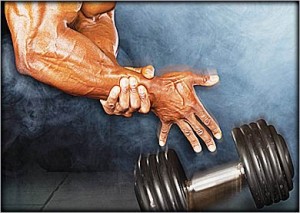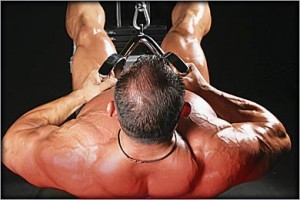 Short of a traumatic injury — like your training partner dropping a heavy dumbbell on your foot, or slipping badly with a flat-bench dumbbell press and taking a crack to your dome — few problems are more detrimental to bodybuilding than tendinitis. With its mixture of pain and inflammation, this condition is deceptively cruel for bodybuilders who engage in repetitive motions. Not only can it force you to pull back on your training, but if severe enough, it may also shut you down completely.
Short of a traumatic injury — like your training partner dropping a heavy dumbbell on your foot, or slipping badly with a flat-bench dumbbell press and taking a crack to your dome — few problems are more detrimental to bodybuilding than tendinitis. With its mixture of pain and inflammation, this condition is deceptively cruel for bodybuilders who engage in repetitive motions. Not only can it force you to pull back on your training, but if severe enough, it may also shut you down completely.
Tendinitis is an inflammation of the connective tissue that attaches muscle to bone. Tendons transmit the forces a muscle generates to the skeletal system. Thus, they’re important mediators of muscle contraction. This relationship, however, puts them in harm’s way because every time a muscle contracts it places stress on the tendon. The most common, but by no means sole, cause of tendinitis is overuse (i.e., repeating the same movements so frequently that they become destructive to the involved structures).
Bodybuilding seems to be the poster activity for tendinitis because it involves the harshest risk factors: intense muscle contractions, repetitive movements and heavy loads. And the condition plays no favorites, afflicting the seasoned veteran as well as the newbie.
WHEN INFLAMATION STRIKES
Here are some strategies you may find useful if you’re struggling with the symptoms of tendinitis.
Warm up well prior to any intense or aggressive lifting. Use light weights for several sets to increase blood flow, particularly to the tendon areas that are prone to lower blood circulation.
Gently stretch the area of discomfort. The tendon attaches the muscle to the bone, so any stretch of the muscle can also place a stretch on the tendon as well. When done with care, stretching may reduce the tension along the whole musculotendinous complex. It can be effectively used before and immediately after working out. Be sure to stretch to tolerance, not pain.
Vary your movement patterns by trying new exercises. Because tendinitis results from overuse, step out of the merry-go-round of repetitive motion and try new movements, even substituting machines for free weights and vice versa.
Ice after working out. One approach is to put a cold pack on the irritated area for 10–15 minutes, depending on the tissue thickness in the area. Be sure to remove the cold pack as soon as the area begins to feel numb. Another method is to use an ice bath in which you plunge the irritated tendon into a bucket filled with cold water and ice chips. This is a more aggressive form of cryotherapy — and isn’t for the faint of heart. When used after stretching this method is even more advantageous because it freezes the tissue in a lengthened position and helps the weight trainer recover more quickly. (Cautionary note: Remove the area from the ice bath as soon as it begins to feel numb.)
Consider bracing the area. For instance, you could wear a neoprene sleeve or Velcro strap over your elbow as you train your biceps or triceps. Studies have shown stress on the tendon may be reduced by more than 80% with bracing. Another way to reduce tendon stress is with a taping method known as Kinesio Taping. Kinesio Tape is different from athletic tape in that it doesn’t lock an area up tightly but better facilitates the muscles to play that role.
USE SUPPLEMENTS TO EASE YOUR TENDON IRRITATION.
 Emphasize eccentric contractions rather that concentric in the areas where you’re feeling tendon stress. An example would be lowering the bar slowly (6–10 counts) in the biceps curl and then having a spotter help you lift the weight into the upright, or contracted, position. Studies have shown that eccentric loading may strengthen the tendon while reducing stress on it. This is an often-overlooked but important method of rehabbing tendons.
Emphasize eccentric contractions rather that concentric in the areas where you’re feeling tendon stress. An example would be lowering the bar slowly (6–10 counts) in the biceps curl and then having a spotter help you lift the weight into the upright, or contracted, position. Studies have shown that eccentric loading may strengthen the tendon while reducing stress on it. This is an often-overlooked but important method of rehabbing tendons.
Modify your “no pain, no gain” philosophy. This begins by carefully listening to your body. Stop training any time you feel sharp pain or an unusual irritation in the area. If you experience prolonged soreness or a deep ache after training you may need to lower your intensity in that muscle group until it becomes clear what those sensations are related to.
Supplement to ease your tendon irritation. A number of supplements, including those that can be used either topically or orally, have been shown to help with tendinitis. Keep in mind, however, that no substance has shown an ability to reverse the cellular damage of tendinitis; only time and healing can do that. But certain supplements may be helpful in reducing the pain and inflammation associated with tendinitis and cultivating a supportive environment for healing. Those noted as being effective are:
>> Fish oil. Some bodybuilding authorities recommend up to 30 grams a day, but 5 grams is a more conservative daily dose that may be effective.
>> Glucosamine sulfate. Take 1,500 milligrams four times a day for the first few days then 1,500 milligrams per day thereafter.
>> Magnesium. Take 250 milligrams two times a day.
>> Methylsulfonylmethane (MSM). Follow the directions on the product label.
>> Vitamin C. 1000–3000 milligrams per day.
Source:emusclemag.com
Post Footer automatically generated by Add Post Footer Plugin for wordpress.